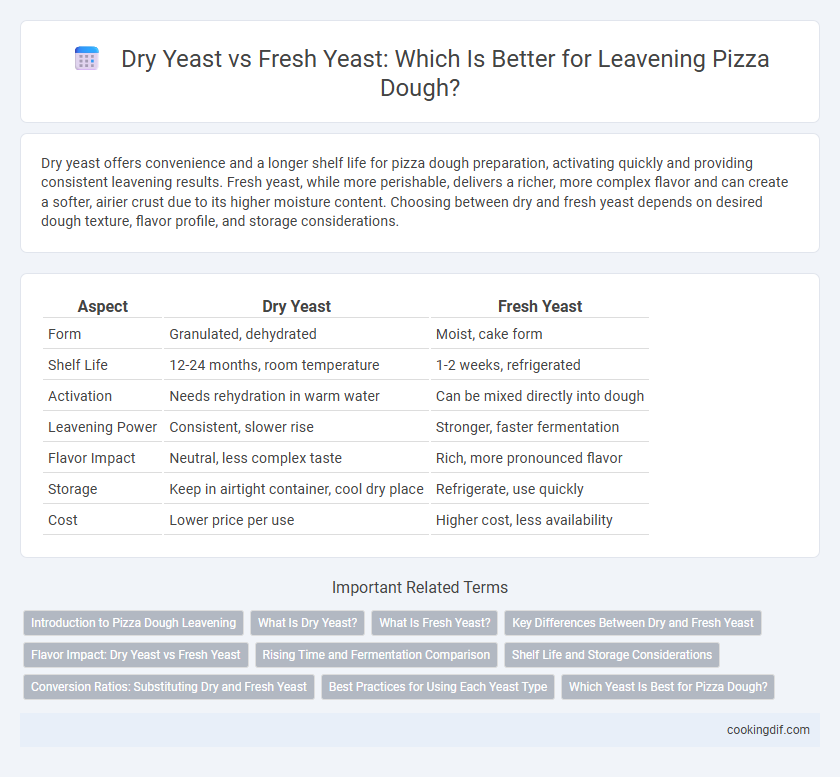Dry yeast offers convenience and a longer shelf life for pizza dough preparation, activating quickly and providing consistent leavening results. Fresh yeast, while more perishable, delivers a richer, more complex flavor and can create a softer, airier crust due to its higher moisture content. Choosing between dry and fresh yeast depends on desired dough texture, flavor profile, and storage considerations.
Table of Comparison
| Aspect | Dry Yeast | Fresh Yeast |
|---|---|---|
| Form | Granulated, dehydrated | Moist, cake form |
| Shelf Life | 12-24 months, room temperature | 1-2 weeks, refrigerated |
| Activation | Needs rehydration in warm water | Can be mixed directly into dough |
| Leavening Power | Consistent, slower rise | Stronger, faster fermentation |
| Flavor Impact | Neutral, less complex taste | Rich, more pronounced flavor |
| Storage | Keep in airtight container, cool dry place | Refrigerate, use quickly |
| Cost | Lower price per use | Higher cost, less availability |
Introduction to Pizza Dough Leavening
Dry yeast and fresh yeast are essential leavening agents for pizza dough, each affecting fermentation and rise times differently. Dry yeast, with its longer shelf life and concentrated form, activates quickly and provides consistent results, while fresh yeast offers a milder flavor and requires careful temperature control for optimal activation. Understanding the properties and usage of both yeast types enhances dough texture, aroma, and flavor development in artisanal pizza making.
What Is Dry Yeast?
Dry yeast, also known as active dry yeast, is a dehydrated form of yeast commonly used in pizza dough leavening for its long shelf life and convenience. It requires activation in warm water before mixing with other ingredients, allowing the yeast cells to become active and produce carbon dioxide, which causes dough to rise. Compared to fresh yeast, dry yeast offers consistent performance and easier storage, making it a popular choice for both home cooks and professional pizzaiolos.
What Is Fresh Yeast?
Fresh yeast, also known as cake yeast or compressed yeast, is a moist, soft block of yeast cells used in pizza dough leavening to produce a light, airy texture. It contains live active yeast cultures that ferment sugars, releasing carbon dioxide and causing the dough to rise more quickly compared to dry yeast varieties. Fresh yeast requires refrigeration and has a shorter shelf life but is preferred by artisanal pizza makers for its consistent fermentation and flavor development.
Key Differences Between Dry and Fresh Yeast
Dry yeast offers a longer shelf life and easier storage compared to fresh yeast, which requires refrigeration and has a shorter expiration period. Fresh yeast provides a more robust flavor and faster fermentation due to its higher moisture content, enhancing the dough's texture and rise. In pizza dough preparation, dry yeast requires rehydration before use, while fresh yeast can be crumbled directly into the mix, affecting the activation process and consistency.
Flavor Impact: Dry Yeast vs Fresh Yeast
Dry yeast offers a more consistent and slightly yeasty flavor, enhancing the dough's subtle tang, while fresh yeast imparts a richer, more complex aroma due to its higher moisture content and microbial activity. Fresh yeast's superior fermentation process produces delicate organic compounds that elevate the depth and complexity of pizza crust flavor. Bakers seeking intense, aromatic profiles often prefer fresh yeast despite its shorter shelf life compared to the convenience and stability of dry yeast.
Rising Time and Fermentation Comparison
Dry yeast offers a longer shelf life and slower fermentation, resulting in a more controlled rising time ideal for overnight dough fermentation. Fresh yeast provides faster fermentation and quicker rising, enhancing dough elasticity and producing a more pronounced flavor in a shorter period. Choosing between dry and fresh yeast influences the texture and taste of pizza crust through variations in fermentation speed and dough proofing times.
Shelf Life and Storage Considerations
Dry yeast offers a longer shelf life, typically lasting up to two years when stored in a cool, dry place, making it ideal for infrequent pizza baking. Fresh yeast requires refrigeration and has a much shorter shelf life, usually about two weeks, which can impact its reliability for consistent dough rising. Proper storage extends leavening effectiveness, with dry yeast's sealed packaging preventing moisture exposure, while fresh yeast must be used quickly to maintain its potency.
Conversion Ratios: Substituting Dry and Fresh Yeast
When substituting dry yeast for fresh yeast in pizza dough, use a conversion ratio of 1:3, meaning 1 gram of dry yeast equals approximately 3 grams of fresh yeast to maintain consistent leavening power. Active dry yeast requires proofing in warm water, while fresh yeast can be crumbled directly into the dough. Adjust hydration slightly if necessary, as fresh yeast contains more moisture than dry yeast, affecting dough consistency.
Best Practices for Using Each Yeast Type
Dry yeast offers long shelf life and easy storage, making it ideal for infrequent baking, while fresh yeast provides superior flavor and faster fermentation but requires refrigeration. Best practices include hydrating dry yeast in warm water before mixing to activate enzymes, whereas fresh yeast should be crumbled directly into dough or dissolved in lukewarm water for even distribution. Adjust hydration levels slightly when using fresh yeast due to its higher moisture content to maintain optimal dough consistency.
Which Yeast Is Best for Pizza Dough?
Dry yeast offers consistent, long shelf life and reliable fermentation for pizza dough, making it ideal for home bakers and commercial use. Fresh yeast provides a milder flavor and faster activation but requires careful storage and has a shorter shelf life. Choosing between dry and fresh yeast depends on desired dough texture, flavor complexity, and convenience in preparation.
Dry yeast vs fresh yeast for leavening Infographic

 cookingdif.com
cookingdif.com